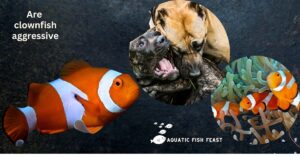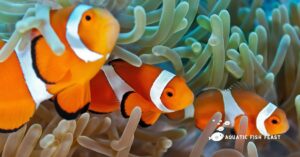Do you want to know if Clownfish can live with seahorses? Based on my observations, both seahorses and Clownfish are magnificent creatures.
Nothing pleased me more as a fish owner than having them in the same tank.
My gut, however, informed me that seahorses could be too delicate for Clownfish.
Can the two indeed coexist?
To address that, I began conducting extensive studies on the subject. Yes, Clownfish and seahorses may coexist, but keeping them in the same tank is not advised.
Unlike seahorses, Clownfish are fast, territorial, and aggressive.
The intense fight for food creates a stressful, unhealthy environment.
However, as we progress through this post, I will demonstrate a few ways you may use to retain both species in the same tank.
Now, let’s get started.
Read Related Post: Can Clownfish Live Alone?
Table of Contents
What Are Seahorses
Many want to own seahorses, unique ocean fish that will get people talking.
There are only about 35 kinds of seahorses, most of which are similar in some way.
Their horse-shaped heads and long noses help most people identify them. They also have a style with a crooked neck.
They don’t have scales on their bodies. In reality, rigid plates cover them.
Another thing that makes seahorses unique is that, unlike other fish, they swim vertically with their dorsal and pectoral fins.
Seahorses move very slowly, but they can get around pretty well.
They seem to float there, not moving at all.
You can usually find them in shallow, calm water near seaweed and macroalgae. They hang their tails from this.
Much of their time is spent looking for food, like copepods, amphipods, and smaller prawns. In addition, they need to be fed several times a day.
They might eat cold foods and other seafood, but it might take them a while to get used to it.
What Is Clownfish
Clownfish are brightly colored, adorable, and occasionally humorous creatures that live on tropical reefs worldwide, including the Great Barrier Reef.
They are resilient fish that may be kept safely in the house for many years if given the right conditions and maintenance.
Clownfish like “Nemo” often have a 2 to 8 cm length. In the wild, they share an uncommon symbiotic interaction with sea anemones.
Clownfish live within the anemone’s tentacles and resist its stings, killing other fish.
They may also deliver food to the anemone, which they eat from its leftovers.
Since they are gregarious fish, keeping at least two in aquariums is advised.
Clownfish for aquariums were traditionally only obtained from the wild, just off the coral. Clownfish farms are currently located throughout Australia.
It is highly advised that anybody looking to raise Clownfish in a home aquarium make sure the fish are aquaculture or captive-bred.
In addition to being healthier and more resilient, captive-bred fish have no adverse effects on the environment, are generally easy to purchase healthy fish, and don’t have particular dietary preferences.
Can Clownfish Live With Seahorses
Aquarium enthusiasts have long shunned seahorses because of their renowned difficulty maintaining an aquarium.
The majority of those who were able to capture seahorses in the wild and keep them alive for a few months were unsuccessful.
But since then, aquarists have managed to decode the code.
Some novices have begun to ask if seahorses and Clownfish can coexist since they now understand the requirements for keeping seahorses alive in an aquarium.
Seahorses and Clownfish get along well with one another regarding their coexistence.
It is not advised, nevertheless, for several reasons:
1. Tense Situations
Seahorses are sluggish animals.
This explains why the water in their aquariums mostly moves slowly. They are a timid, kind species.
The reverse is true with Clownfish. Just because they swim quickly will be difficult for your seahorses to overcome.
The seahorse will probably start feeling stressed out because of the Clownfish.
When one considers that a seahorse’s immune system may be weakened by prolonged stress, the problem becomes more serious.
This might lead to unwell seahorses who have far shorter lives.
Diseases may quickly spread across a group of seahorses you maintain, eventually affecting all the fish in the tank.
Hene, you should separate the two immediately if your Clownfish swims quickly in the seahorses’ area.
2. Food-related Competition
Seahorses consume copepods, which are tiny crustaceans and algae. The issue, though, is that they are not hostile hunters.
Placed another way, they will not win if you put them in a race against most other tank fish for food.
Seahorses eat pretty slowly, so don’t expect them to battle other fish for food if you spray it all over your tank.
Conversely, Clownfish have aggressive inclinations. During mealtimes, they won’t think twice about bullying their tank mates.
Before the seahorse can get to the food, they will probably devour all you have put in the tank.
Put another way, and your seahorses risk starving if kept in a tank with Clownfish.
They cannot secure their meals unless you shoot the food right into the corner of the tank, which is a location with a low stream. That is not going to occur in a clownfish tank.
3. Potential hostility
Clownfish show territorial inclinations, even though they may live harmoniously with other animals.
A seahorse is likely to suffer damage if it ventures into clownfish habitat. This is a common occurrence in aquariums.
When confronted with aggressive Clownfish, most other fish who stray into their domain are swift and physically decisive enough to flee. This is what they do before they get hurt.
Some can even retaliate.
What Are The Potential Risks If Kept Together
1. Possible Attacks.
Clownfish and seahorses may be kept, but there’s always a potential for uncertainty, so be prepared for that.
Even though certain Clownfish are considered harmless and nonaggressive, not all aggressiveness is equal to low aggression.
Mean, aggressive behavior is still possible.
They might not go straight after seahorses, but they might act aggressively and become bullies.
Territorial tendencies are another characteristic of Clownfish; even the more docile varieties may exhibit them in certain circumstances.
When the Clownfish are tiny, I doubt you will have any difficulties with them at first, but as they become more prominent, things become problematic.
2. Race Course.
Competition for resources remains a real risk when maintaining seahorses, among other fish. These ponies eat slowly and subtly and are easily surpassed in appetite.
Clownfish are voracious eaters, so even if you give your tankmates ample food, you might still observe competition for few resources.
It takes careful planning to keep these fish in the same tank as each other, ensuring they are properly fed and cared for.
3. Disease Transference
There’s always the risk of bringing undesired illnesses or parasites into the system when adding new tanks.
To reduce the possibility of spreading these illnesses, it is thus preferable to quarantine any new tank mates before you can add them to the aquarium.
Because seahorses are notoriously messy feeders, a variety of harmful bacterial illnesses can arise from this behavior.
Because they are more prone to infection, this might cause tank mates to get ill, putting everyone in danger.
Clownfish should also be regarded as Ich (Cryptocaryon irritans) magnets since they are susceptible to Brooklynella and Marine Velvet (Amyloodinium).
Tank mates should only be added to any system once the proper quarantine procedures have been completed.
What Other Animals Live With Seahorses
Numerous prawn species and other bottom-feeding animals may cohabit alongside seahorses. Gobies are also valuable allies for tanks.
Sea anemones, octopuses, tangs, triggerfish, squid, and eels are typically discouraged for keepers.
Seahorses in aquariums depend heavily on the quality of the water to survive. Since they are sensitive species, adding them to a new tank is not advised.
The suggested water parameters are as follows; however, these fish could eventually adjust to alternative conditions:
- Temperature range: 73–82 °F (23–28 °C).
- 8.1–8.4 pH
- Ammonia: 0 ppm, or mg/L for brief periods, 0.01 mg/L (0.01 ppm) may be tolerated.
- Nitrite: ppm = 0 mg/L for brief periods; 0.125 mg/L (0.125 ppm) may be tolerated.
- S.G.: at 23–24 °C (73–75 °F), 1.021–1.024
Fish with poor water quality will exhibit altered behavior, which includes clamped fins, decreased eating, irregular swimming, and surface gasping.
Seahorses use the entire length of the aquarium in addition to swimming up and down it. As a result, the tanks ought to be twice as deep as the mature seahorse’s length.
Final Thought
Now that we have established that clownfish can live with seahorses, while clownfish and seahorses may coexist in a tank, you should avoid doing so as a fish owner.
Clownfish are fast and aggressive, but seahorses are sluggish and placid swimmers. High levels of stress and food competition may result in a sick seahorse.
If you want to keep them together, acquire a big tank (at least 25 gallons) and place the anemone or coral in one corner.
You might also use a barrier to prevent interactions between your Clownfish and seahorses.
This article answered some of your questions. If you have any more, please contact me via the contact page. In the meantime, I hope you enjoy your aquarium and everything it offers.




